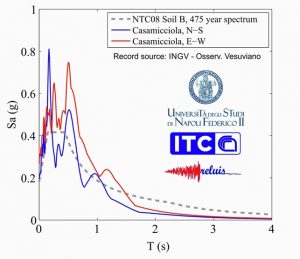the earthquake of casamicciola, IN THE ISLAND OF ISCHIA: Was it just a “small” earthquake or a disastrous event?

All the earthquakes occurred in Italy over the last years share one common feature, that is, the preposterous communication coverage by self-styled experts. In the case of the seismic event of August 2017 in Casamicciola, even before understanding what the characteristics of the seismic motion were, many people were already wondering “How come a modest earthquake, rated 4 on the Richter magnitude scale, did so much damage?”
Very briefly, the Magnitude measures the energy released by an earthquake and is a key indicator of the intensity of the phenomenon on a geological scale. However, it DOES NOT measure the effects of an earthquake on people and buildings. At least, Magnitude alone is not enough to do so.
As it is known, buildings undergo the effect of the earthquake through the action of inertial forces, directly proportional to the acceleration, which is therefore the main indicator of the effects of an earthquake on buildings. By closely examining the accelerometric signal recorded by the IOCA station, located close to the epicenter, it is easy to notice that the horizontal accelerations on the ground were almost 30% of the acceleration of gravity, thus reaching very significant values. Even worse, the energy content of the seismic motion was such as to cause horizontal spectral accelerations equal to about 80% of the acceleration of gravity for 2/3-storey buildings, which are the most common building typology in the oldest area of Casamicciola.
Therefore, in this respect, the earthquake was anything but small, as its intensity was significant: seismic actions on buildings were greater in intensity than the limits imposed by law today when it comes to building new homes in Casamicciola.
The attached report goes into the technical details of the recorded accelerometric data available. The report also shows that there have been very high vertical accelerations such as to alternately double and nullify the weight of the buildings. The effect of the seismic motion was such as to cause a vertical displacement of the ground amounting to a few centimeters (www.irea.cnr.it).
In conclusion, the seismic action was, in general, intense and far from small, despite the Magnitude not being particularly high. The buildings that, due to different reasons, were more vulnerable, have suffered accordingly, also resulting in a number of partial collapses, and, in some cases, total collapses. Given the current state of knowledge, such high values of measured accelerations may be associated with the very small distance between the earthquake’s hypocenter and the buildings and with the topographic effect due to the hilly morphology of the part of territory around Casamicciola that was most severely affected by the seismic phenomenon.
Prof. Ing. Antonio Occhiuzzi
Director of ITC-CNR
